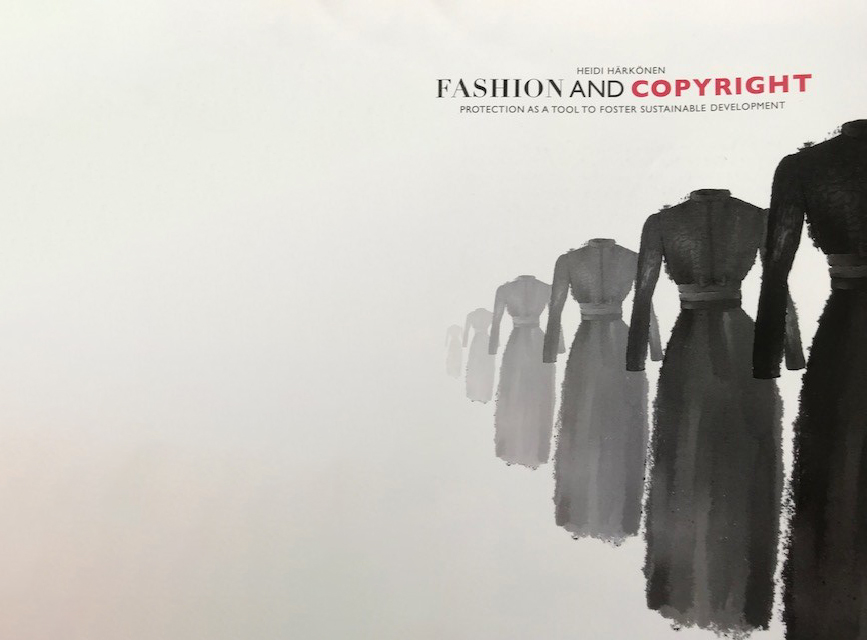Doctoral Dissertation: Heidi Härkönen – Fashion, Copyright and Sustainable Development

 On Friday 10 September 2021 Heidi Härkönen, LL.M., successfully defended her doctoral dissertation “Fashion and Copyright Protection as a Tool to Foster Sustainable development” at the University of Lapland. As opponents functioned Professor Eleonora Rosati from Stockholm University and Professor Katja Weckström from the University of Eastern Finland.
On Friday 10 September 2021 Heidi Härkönen, LL.M., successfully defended her doctoral dissertation “Fashion and Copyright Protection as a Tool to Foster Sustainable development” at the University of Lapland. As opponents functioned Professor Eleonora Rosati from Stockholm University and Professor Katja Weckström from the University of Eastern Finland.
The dissertation is composed of two peer-reviewed articles in Finnish published in Defensor Legis 2018 and 2020, two peer-reviewed articles in English published in the Journal of Intellectual Property Law as well in 2018 and 2020, and a book chapter in “Legal Design: Integrating Business, Design & Legal Thinking with Technology” edited by Marcelo Corrales Compagnucci, Helena Haapio, Margaret Hagan and Michael Doherty, which appeared this year. The chapter is written together with Rosa Maria Ballardini and Iiris Kestilä.
In an integrative chapter (pp. 17 -110) Härkönen introduces the research questions, the scope of the research and the research methods, and summarizes the results. As the title of the dissertation indicates she investigates the applicability of the copyright framework to fashion design from the perspective of sustainable development.
Härkönen asks four questions, i. e.
1. What is the current EU copyright environment like for fashion designs? Is it optimal from the perspective of sustainable development and overall fairness towards creators? Can one talk about a full-copyright or a low-copyright regime?
2. What are the sustainability-related consequences of the fashion industry working in a low-copyright environment, and what does the optimal copyright law environment look like that would encourage the fashion industry to embrace more sustainable business practices?
3. Härkönen notes that there are two blind spots in copyright law, and in IP law in general, when it comes to copying in the context of fashion, i. e. cultural appropriation copying, and private copying of fashion design. As a consequence of this should law be amended or its interpretation changed in order to promote sustainable development?
4. Taking into account the technological advancements will artificial intelligence, AI, affect the sustainable development of the fashion industry?
Together with the research questions she presents four hypotheses, which indicates the answers and which she is arguing for in the dissertation.
Based on the research, it seems that the EU has been living in a low-copyright regime for fashion but considering the latest judgements by the Court of Justice of the European Union, CJEU, the copyright environment is changing and becoming more sustainably positive. This is connected to the judgements Cofemel, C-683/17 and Brompton, C-833/18. By considering all works both pure art and applied art as equal the copyright development from the perspective of fairness, creativity and sustainable development is according to Härkönen moving in the right direction.
She questions the so-called Piracy Paradox introduced by Raustiala and Sprigman in 2006 and argues that the contemporary fashion industry is flourishing in a low-copyright regime, which the authors seem to cherish, and this appears to be the very problem. A broad space for copying might very well force the fashion designers to be more creative but at the same time it fosters fast fashion, which is most problematic for sustainability. There is no reason to defend the paradox, but I suspect that Raustiala and Sprigman have looked at the incentivising function of intellectual property rights and ignored the medium- and long-term costs of the environmental and labour consequences of fast fashion, which have become most relevant during recent years. Stronger property rights might after all have positive economic effects for the society and thus the individuals.
Härkönen argues furthermore that by awarding copyright to traditional cultural expression appropriation can be hindered. This and allowing private copying of fashion design promotes sustainability. Apparently, both can be achieved through interpretation of existing regulation.
She seems finally to argue for awarding AI personhood and by that making copying less attractive and slowing the negative effects on sustainability. I think the same can be achieved by giving the copyright to the person who has most relevantly promoted or affected the creation of the algorithm and by this preserve the existing regime.
In conclusion it is important to point out that Härkönen of course is well aware of the effect of the changing copyright regime on sustainability being its vigorous enforcement. Furthermore, it is a matter of attitude and legal measures also taken within other fields of law, such as taxation, environmental, labour, competition and advertising law, as well as consumer protection.
This brief description of the dissertation does of course not give justice to the excellently structured integrative chapter and the well-argued conclusions as well as the many themes she is touching upon. It has furthermore been a pleasure to read the well formulated texts, particularly in English, but also in Finnish. I do warmly recommend it to all who are working within the field of IPR, not only those who are engaged with fashion law.
Kirjoittajat





